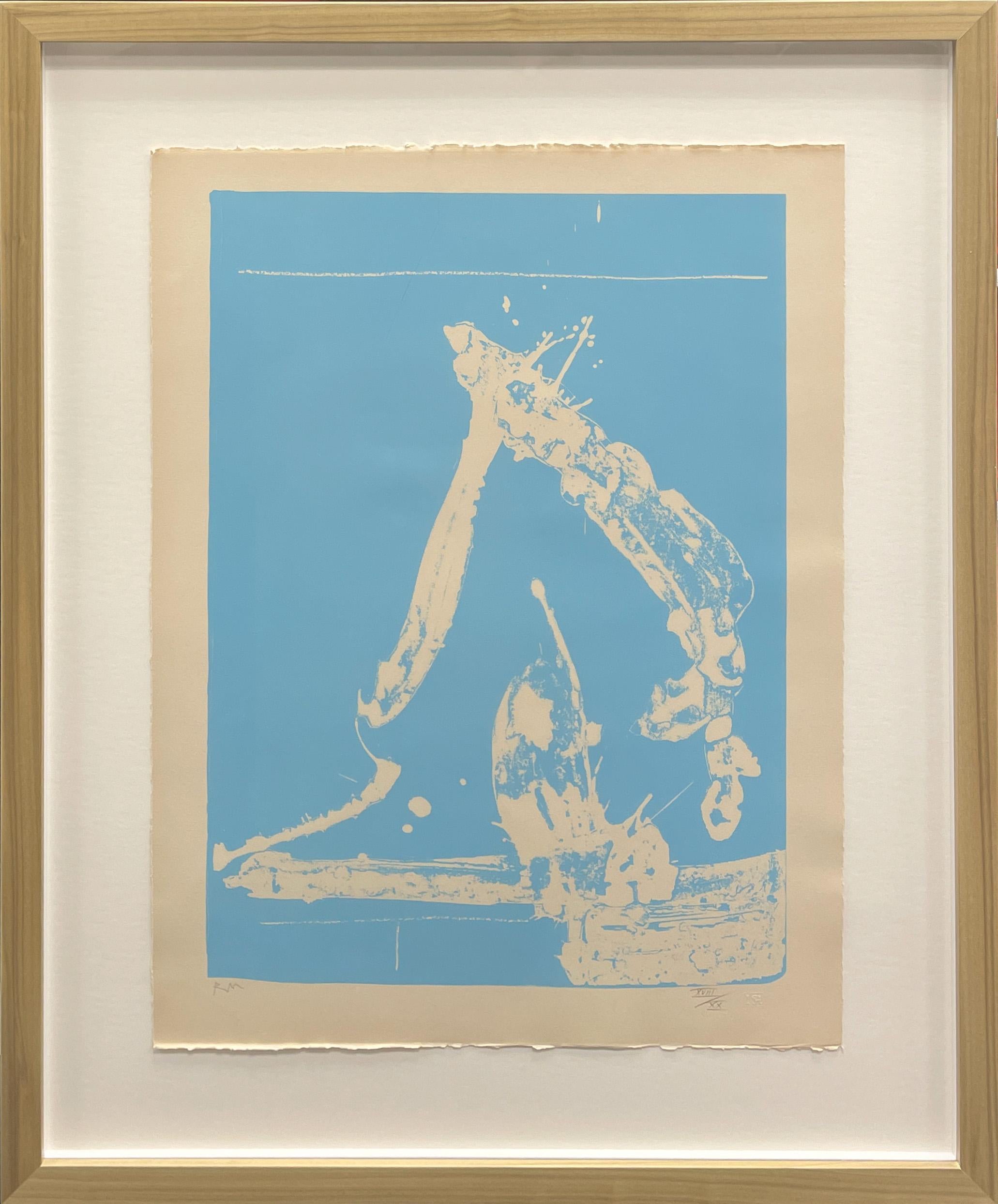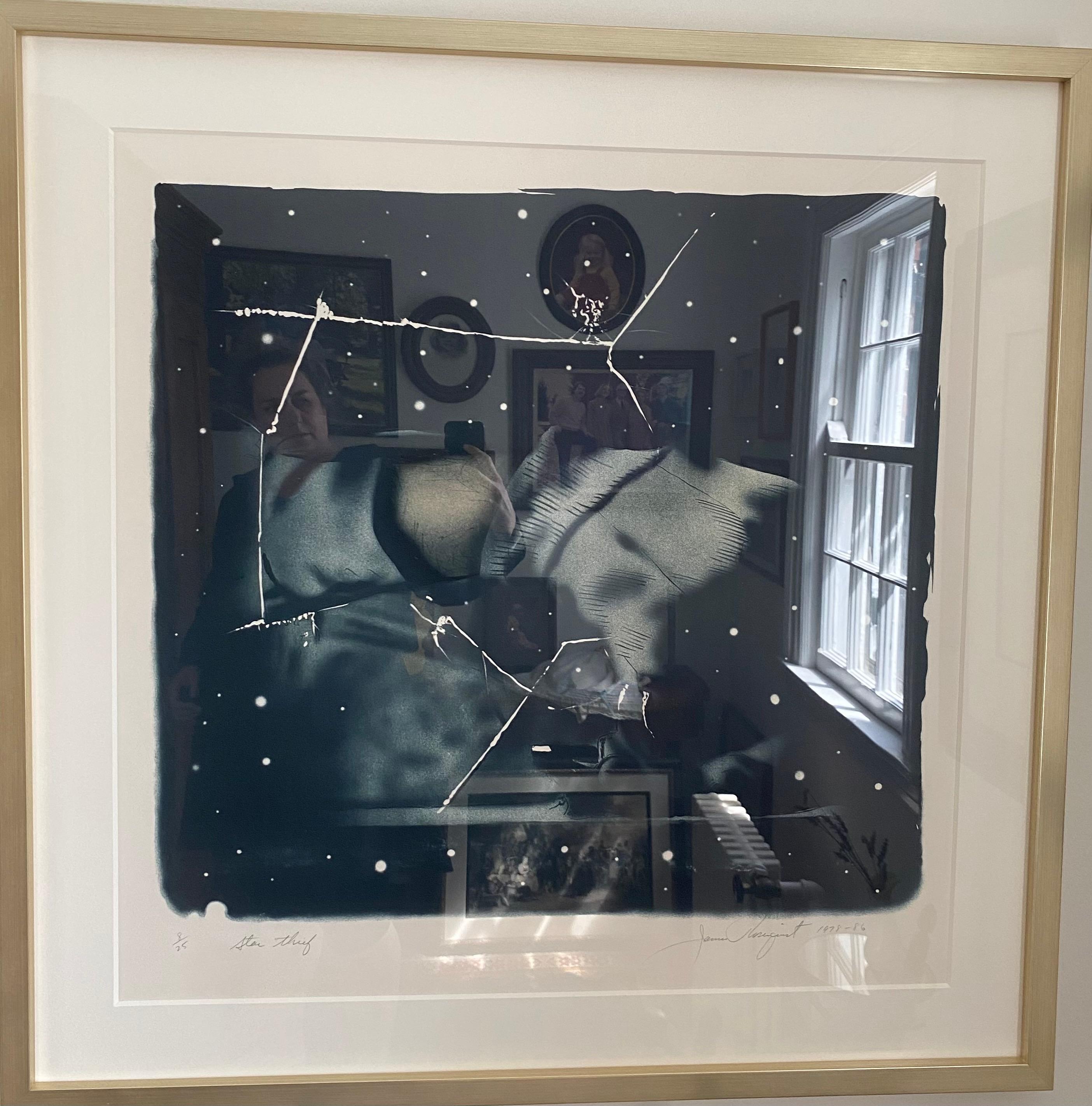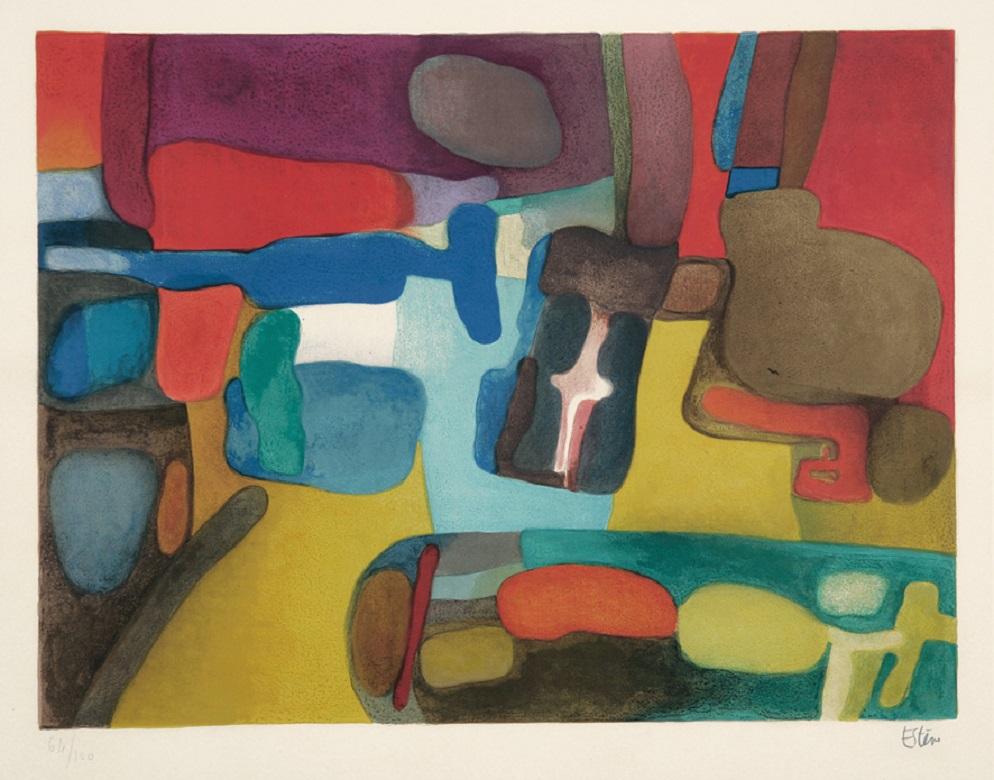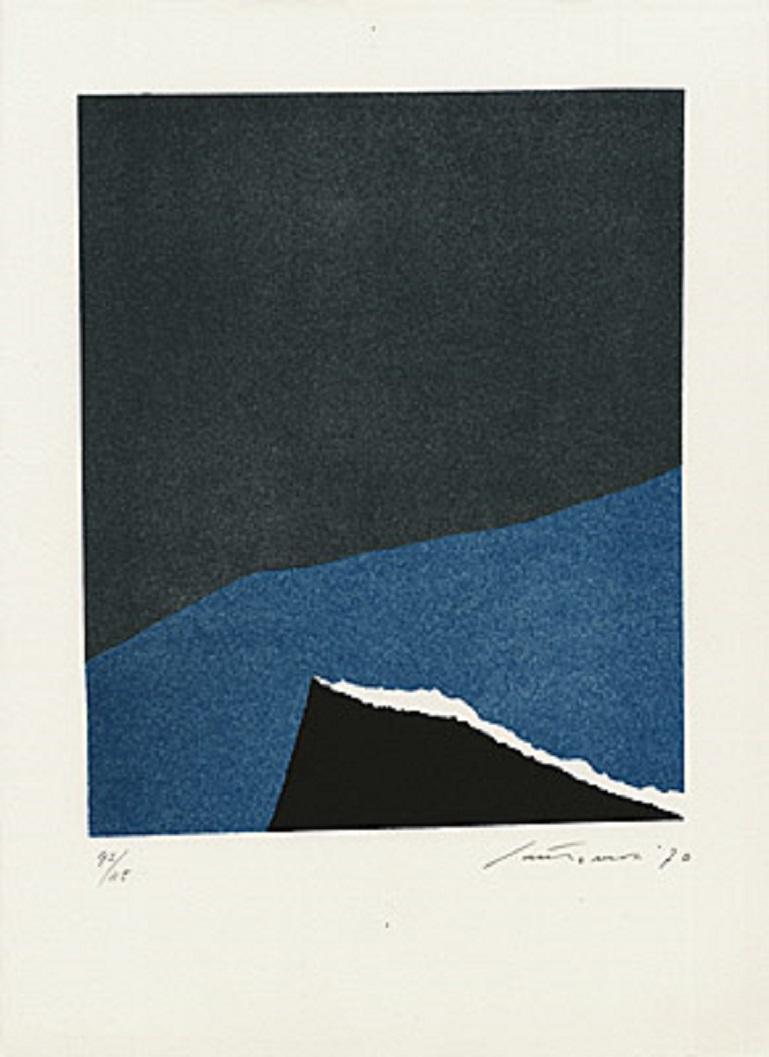Joan MiróSculptures et Ceramiques1973
1973
About the Item
- Creator:Joan Miró (1893 - 1983, Catalan)
- Creation Year:1973
- Dimensions:Height: 48 in (121.92 cm)Width: 36.75 in (93.35 cm)Depth: 2.25 in (5.72 cm)
- Medium:
- Movement & Style:
- Period:
- Condition:
- Gallery Location:San Francisco, CA
- Reference Number:
Joan Miró
With his wide-ranging oeuvre, comprising strikingly original paintings, prints, ceramics, sculptures, metal engravings and murals, Catalan modernist Joan Miró was a critical force in moving 20th-century art toward complete abstraction. Although often considered an early Surrealist because of his nonobjective imagery and evocation of the subconscious, he defies neat categorization.
Miró’s identity is largely rooted in the city of his birth: Barcelona. To this day, a number of his public artworks can be found there, including the 72-foot-tall statue Dona i Ocell (Woman and Bird), 1983. Female and avian forms, along with bright colors and the theme of Catalan pride, are recurring elements in his work.
The radical visual world Miró created with his expressive lines, signature symbols and biomorphic shapes influenced such American Abstract Expressionists as Jackson Pollock and Color Field painters like Mark Rothko and Barnett Newman.
Mirò continued to work and experiment until his death at the age of 90 in 1983. Five years before that, he was quoted saying, “I painted these paintings in a frenzy, with real violence so that people will know that I am alive, that I’m breathing, that I still have a few more places to go. I’m heading in new directions.”
Find a collection of original Joan Miró art on 1stDibs.
- ShippingRetrieving quote...Ships From: San Francisco, CA
- Return PolicyA return for this item may be initiated within 7 days of delivery.
- Spectral VisionBy Zao Wou-KiLocated in San Francisco, CAThis artwork titled "Spectral Vision" 1970, is an original color lithograph by renown Chinese/American artist Zao Woo Ki, 1921-2013. It is hand signed and inscribed H.C. (Hors Commerce) in pencil by the artist. The image size is 17.25 x 24.5 inches, framed size is 32.65 x 39 inches. Custom framed in a wooden silver frame, with silver color spacer and fabric matting. It is in excellent condition. About the artist: Zao Woo Ki was born in Beijing with family roots in Dantu, Zhenjiang, Jiangsu province. In his childhood he was brought back to his hometown Dantu where he studied calligraphy. From 1935 to 1941, he studied painting at the China Academy of Art in Hangzhou, Zhejiang province, where he was taught by Lin Fengmian, Fang Ganmin and Wu Dayu. In 1948, he went with his wife Lan-lan, a composer, to Paris to live on the same block in Montparnasse where the classes of Émile Othon Friesz took place. His earliest exhibitions in France were met with praise from Joan Miró and Picasso. In 1957, Zao decided to visit the United States where his younger brother Chao Wu-Wai was living in Montclair, New Jersey, close to the art scene of New York City. He wanted to learn more about "pop art". While in the US, he painted seven canvases at his brother's house. There are relatively few items dating from that year (1957). Years later, the largest canvas was given by his brother, Chao Wu-Wai, to the Detroit Institute of Arts. He left the U.S. after a six-week stay, traveling to Tokyo and then to Hong Kong, where he met his second wife Chan May-Kan Zao's works, influenced by Paul Klee, are orientated to abstraction. He names them with the date in which he finishes them, and in them, masses of colours appear to materialise a creating world, like a Big Bang, where light structures the canvas. He worked formats in triptychs and diptychs. While his work was stylistically similar to the Abstract Expressionists whom he met while travelling in New York, he was influenced by Impressionism. Zao Wou-Ki stated that he had been influenced by the works of Matisse, Picasso and Cézanne.[ His meetings with Henri Michaux pushed him to review his Indian ink techniques, always based in Chinese traditional drawings. Zao was a member of the Académie des beaux-arts, and was considered to have been one of the most successful Chinese painters during his lifetime. In 1982, he was invited to paint for the Fragrant Hills Hotel in Beijing, designed by I. M. Pei. In 1983, he returned to his alma mater, the China Academy of Art in Hangzhou to give lectures. Former French President Jacques Chirac was offered a painting by Zao Wou-Ki by his ministers during their last meeting. His auction record of HKD 510 million was set at Sotheby's, Hong Kong, on 1 September 2018. Zao's work 'Juin-Octobre 1985' is now the most expensive painting ever to go under the hammer at auction in Hong Kong. By the end of his life Zao had stopped producing new paintings due to health problems. He died on 9 April 2013 at his home in Switzerland. Selected public collections and museums: Vienna, Albertina Museum, Graphische Sammlung Brussels, Museum of Modern Art Brussels, Royal Museums of Fine Arts of Belgium Rio de Janeiro, Museum of Modern Art Montreal, Museum of Contemporary Art of Montreal (Quebec) Montréal, Museum of Fine Art (Quebec) Quebec City, National Museum of Fine Arts of Quebec (Quebec) Toronto, Art Gallery of Ontario (Ontario) Hangzhou, China Academy of Art Hong Kong, Hong Kong Museum of Art Beijing, China Central Academy of Fine Arts Suzhou, Suzhou Museum Helsinki, Ateneum Museum Tempere, Sara Hildén Art Museum Châteauroux, Bertrand Museum Colmar, Unterlinden Museum Dunkirk, LAAC Évreux, Museum of Art, History and Archeology Gravelines, Musée du Dessin et de l’Estampe Originale Issoudun, Musée de l’Hospice Saint-Roch Le Havre, Malraux Museum Lyons, École normale supérieure Metz, Museum of Art and History Montauban, Ingres Museum Montpellier, Fabre Museum Nantes, Museum of Fine Art Orléans, Museum of Fine Art Paris, L’Adresse – Musée de La Poste Paris, Bibliothèque nationale de France Paris, Bibliothèque de l’Institut de France Paris, Centre Pompidou, National Museum of Modern Art / Industrial Design Center Paris, Cercle de l’Union Interalliée Paris, Fonds National d’Art Contemporain Paris, Institut national d’histoire de l’art Paris, Manufacture Nationale des Gobelins Paris, Manufacture Nationale de la Savonnerie Paris, Manufacture Nationale de Sèvres Paris, Mobilier National Paris, Museum of Modern Art of Paris Paris, Cernuschi Museum Paris, Musée du Louvre (at Musée Fabre in Montpellier) Paris, Schlumberger Ltd. Paris-La Défense, Société Générale Paris-La Défense, TOTAL France Rennes, Museum of Fine Art Saint-Dié-des-Vosges, Musée Pierre-Noël Sceaux, Musée de l’Ile-de-France, Château de Sceaux Tournus, Musée Greuze Tours, Museum of Fine Art Tours, Conseil général d’Indre-et-Loire, fourteen windows for La Demeure de Ronsard, La Riche Valence, Museum of Fine Art and Natural History Essen, Folkwang Museum Liverpool, The Tate Gallery London, The Tate Gallery London, Victoria and Albert Museum Jakarta, Jakarta Museum Tel Aviv, Tel Aviv Museum Genova, Gallery of Modern Art Milan, Museum of MOdern Art of Milan Fukuoka, Fukuoka Art Museum Fukushima, Iwaki City Art Museum Hakone-Machi, The Hakone Open-Air Museum Kyoto, Kyoto National Museum of Modern Art Nagaoka, Nagaoka Contemporary Art Museum Osaka, National Museum of Art Tokyo, Bridgestone Museum of Art, Ishibashi Foundation Luxembourg City, Grand Ducal Collections of the State of Luxembourg Luxembourg City, National Museum of History and Art Skopje, Museum of Contemporary Art Mexico, Centro Cultural/Arte Contemporáneo Mexico, Museum of Modern Art Mexico, Tamayo Museum of Contemporary Art Castelo Branco...Category
Late 20th Century Abstract Expressionist Abstract Prints
MaterialsLithograph
- Ball Figures IBy Jonathan LaskerLocated in San Francisco, CAArtist: Jonathan Lasker– American (1948- ) Title: Ball Figures I Date: 2003 Medium: Three Color lithograph on BFK Rives paper Publisher: Tamarind Institute. Tamarind number: 03-304 ...Category
Early 2000s Abstract Abstract Prints
MaterialsPaper, Lithograph
- VolubilisBy Stanley William HayterLocated in San Francisco, CAArtist: Stanley William Hayter (1901-1988 ) Title: Volubilis Date: 1969 Medium: Lithograph Image Size: 25.75 x 19.75 inches Sheet size: 25.75 x 19.75 inches – BFK Rives paper Signature: signed, dated lower right Publisher: Desjoberts, Paris Catalogue Raisonne: B&M 331 Edition: 50 plus 10 proofs. This one: 19/50 This exceptional color lithograph is an excellent example of Stanley William Hayter’s iconic printmaking. He is the founder of Atelier 17, and as such, one of the most influential printmakers of the 20th century. Volubilis was published in 1969, and is B&M 331 in the catalog raisonne. The print is in good condition aside from soft handling creases, stray printing ink in the lower right corner, 6 in. surface rub upper left corner which is barely visible upon very close inspection. Please see photographs. Stanley William Hayter CBE (27 December 1901 – 4 May 1988) was an English painter and printmaker associated in the 1930s with surrealism and from 1940 onward with abstract expressionism. Regarded as one of the most significant printmakers of the 20th century, in 1927 Hayter founded the legendary Atelier 17 studio in Paris. Since his death in 1988, it has been known as Atelier Contrepoint. Among the artists who frequented the atelier were Pablo Picasso, Alberto Giacometti, Joan Miró, Alexander Calder, Marc Chagall, Nemesio Antúnez...Category
1960s Abstract Abstract Prints
MaterialsPaper, Lithograph
- Poetes, Sculpteurs, PeintresBy Joan MiróLocated in San Francisco, CAThis artwork titled "Poetes, Sculpteurs, Peintres" 1960, is an original color lithograph on Rives paper by renown artist Joan Miro 1893-1983. It is hand signed (monogramed) and numb...Category
Late 20th Century Abstract Abstract Prints
MaterialsLithograph
- Ideas From a SketchbookBy Henry MooreLocated in San Francisco, CAArtist: Henry Moore (British, 1898-1986) Title: Ideas From a Sketchbook Year: 1976 Medium: Color lithograph Edition: 110 Paper: Arches Image size: 18.5 x 15 inches paper size:...Category
1970s Abstract Abstract Prints
MaterialsLithograph
- UntitledBy Leonardo NiermanLocated in San Francisco, CAArtist: leonardo Nierman (Mexican, born 1932) Title: Untitled Year: Circa 1970 Medium: Color lithograph with embossing Edition: Numbered 139/200 in pencil Image size: 22 x 1...Category
1970s Abstract Abstract Prints
MaterialsLithograph
- "Untitled" Robert Motherwell from the Portfolio of NineBy Robert MotherwellLocated in Hinsdale, ILRobert Motherwell Untitled (from Portfolio 9), 1967 Lithograph, 1967 22.25 x 17.25 in. (56.52 x 43.82 cm.) Signed; lower left with artist's trademark initials; numbered, Publisher...Category
1960s Abstract Expressionist Abstract Prints
MaterialsLithograph
- "Flower Garden" original color lithograph by James RosenquistBy James RosenquistLocated in Hinsdale, ILJAMES ROSENQUIST (B. 1933) "Flower Garden" Lithograph in colors on Hodgkin handmade paper, 1972 22” x 28 5/8” (55.9 x 72.7 cm) (image) 30 ½” x 36 ¼” (77.5 x 92.1 cm) (sheet) Edi...Category
1970s Abstract Expressionist Abstract Prints
MaterialsLithograph
- "The Star Thief" by James RosenquistBy James RosenquistLocated in Hinsdale, ILJames Rosenquist (1933-2017) Star Thief Color lithograph on white wove paper, 1978-1986 Image size: 31.75” x 32”, full margins. Impression 8 of edition of 25 Signed, titled, da...Category
1980s Abstract Expressionist Abstract Prints
MaterialsLithograph
- Cali - 20th Century, Maurice Estève, Abstract Print, Colourful, LithographBy Maurice EstèveLocated in Köln, DE"Cali" is a typical motif by Maurice Estève. The lithograph in colours was published in an edition of 100. 49,6 x 65 cm. Signed and numbered.Category
1960s Abstract Abstract Prints
MaterialsLithograph
- "El patito feo" by Antonio Saura, Abstract Print, Duckling, Blue, Bright ColorsBy Antonio SauraLocated in Köln, DEColor lithgraph by Antonio Saura "El patito feo", 1997 65 x 50 cm Copy 186/250 Edition of 285 Antonio Saura (Huesca, Spain 1930–1998 Cuenca) found his...Category
1990s Abstract Abstract Prints
MaterialsLithograph
- Untitled from "Vingt-deux poèmes" by Giuseppe Santomaso, Black, Blue, CassouBy Giuseppe SantomasoLocated in Köln, DEColor lithograph by Giuseppe Santomaso Untitled from "Vingt-deux-poèmes" (Portfolio with artworks by several artists and 22 poems by Jean Cassou. The work...Category
1970s Abstract Abstract Prints
MaterialsLithograph






